Pietrasanta in Italy is a lovely medieval town known for its artistic tradition. It is named the Little Athens of Italy. Guess why? Thanks to the many international artists that chose it as their adopted country. You will find marble and bronze workshops, artists, and monuments.
I am so in love with this town and its historic center. I am glad to have found my job here. The first time I saw Piazza del Duomo, its beauty left me breathless. I consider Pietrasanta a tiny jewel of Tuscany set on a strip of land between the Mediterranean Sea and the mountains of the Apuan Alps.

Enjoy a pleasant walk to Piazza Duomo and through the streets of the center with the little workshops, the local specialty shops, the art galleries, and temporary exhibitions. And I suggest you take your time to get a typical Italian aperitif in one of the bars that face the square.
Where is Pietrasanta in Italy
The town is part of Versilia, the coastal area of northern Tuscany. It is about 20 miles north of Pisa and 15 miles south of Carrara, the world marble capital. The walled town of Lucca is only 30 minutes away by car using the A12 highway.
Being only 2 miles off the coast, Pietrasanta is also a perfect summer destination in Tuscany. You can quickly reach the beaches of Marina di Pietrasanta and the luxury atmosphere of Forte dei Marmi in fifteen minutes.
Florence is 115 km (71 miles) away. With the car, you only need 1 hour and 30 minutes. Also, the use of the train between Firenze and Pietrasanta is convenient and fast. You have to change the train in Pisa Centrale but is not a big deal.
As you see Pietrasanta makes a perfect base for exploring the northern part of Tuscany. From the less-known area of Lunigiana to the historical cities of Pisa, Lucca, and Florence.
It is also the best place to stay in Tuscany to visit the famous Cinque Terre and Portovenere. In about an hour by train, you can enjoy the colors of Liguria and of the Five Lands.
Pietrasanta. Town of artists and workshops
Since its foundation in 1200 by Guiscardo da Pietrasanta, chief magistrate of the close town of Lucca, the village was a crossroads of artists coming from all over the world.
The origins of Versilia’s artistic marble-working tradition go far back in time. Under the Medici government, there were marble quarries opened in the nearby mountains, the Apuan Alps. Many artists, including Michelangelo Buonarroti, visited Pietrasanta to learn the skills of local artisans, working with them and getting the best white marble for his famous works of art.
Many of them also donated their art pieces to the town making Pietrasanta a real open-air museum.
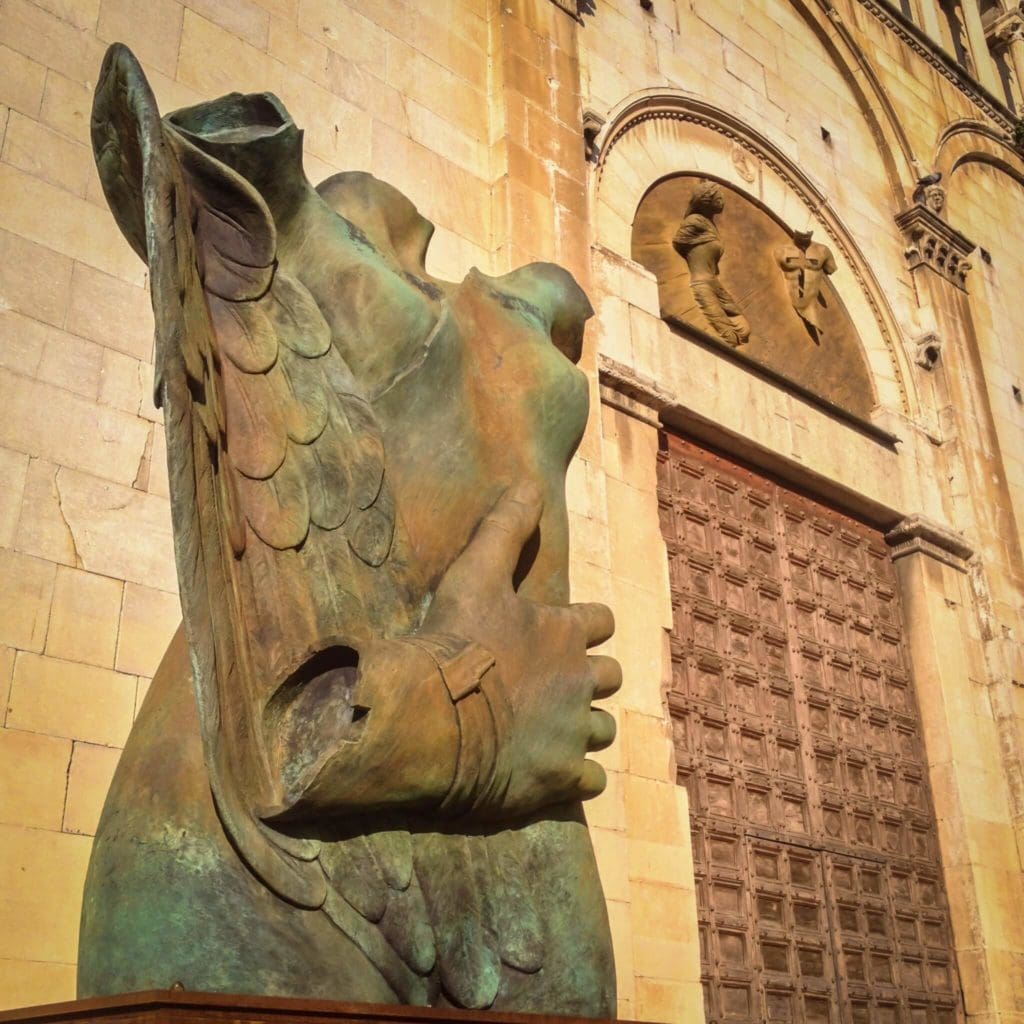
Pietrasanta is one of the most qualified centers for the art of sculpture. There are numerous artisan studios and foundries scattered in the town. They are often run by families that hand down skills from generation to generation.
The nineteenth-century Italian poet Giosuè Carducci, awarded the Nobel Prize for literature in 1906, in a letter said:
“I like Pietrasanta. A beautiful small city with a unique square, a cathedral worth of a great city, all against the background of the Apuan Alps. And what a landscape all around! What a mountain, what greenery, what a shadow, what a river, what cool streams running merrily under the chestnuts, olives, and orange trees, and the marble quarries flank the greenery on every side!”
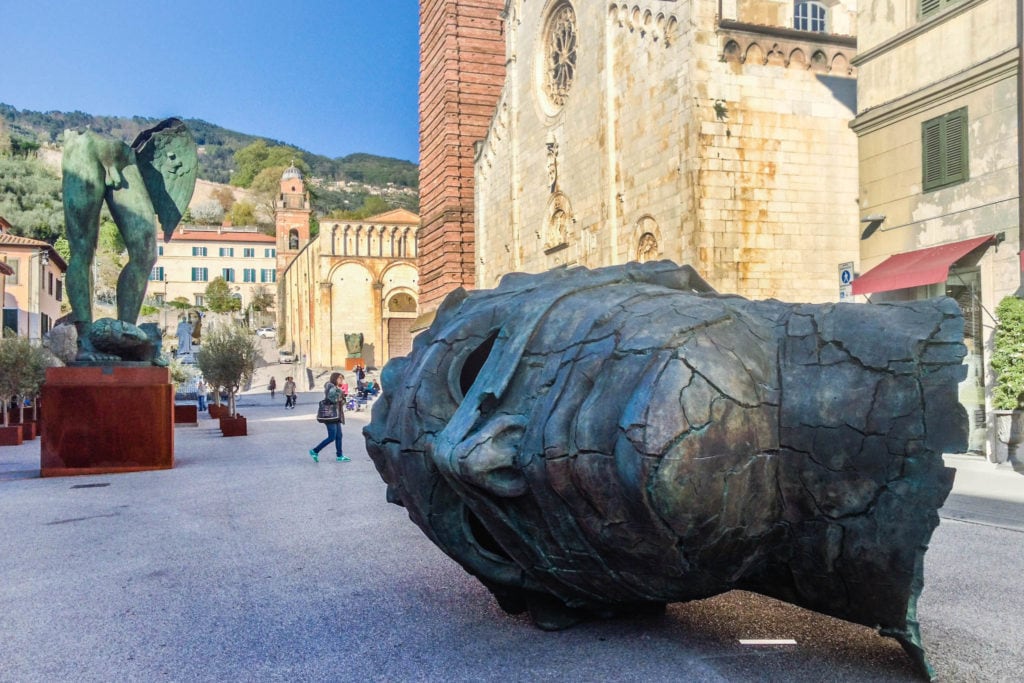
Pietrasanta and the Via Francigena
Pietrasanta was also a way station along the Via Francigena, the pilgrim route connecting Canterbury in England to Rome. More and more modern pilgrims have been choosing to walk the Francigena’s Path instead of the overcrowded Camino de Santiago. A pleasant way to discover Italy. Slowly, with no rush.
THE MAP AND THE ITINERARY OF VIA FRANCIGENA IN TUSCANY
What to do in Pietrasanta Italy
Here are the best things to do in Pietrasanta to enjoy the little Athens of Tuscany at its best.
Potter around the historical center of Pietrasanta
The town is quite small and the best way to discover its beauty is by walking around. You won’t get lost but you will find art everywhere. Have fun recognizing statues of famous artists like the Warrior by Botero or the Centaur by Mitoraj. If you wish to get the best gelato go to the gelateria La Cremeria in front of the train station.
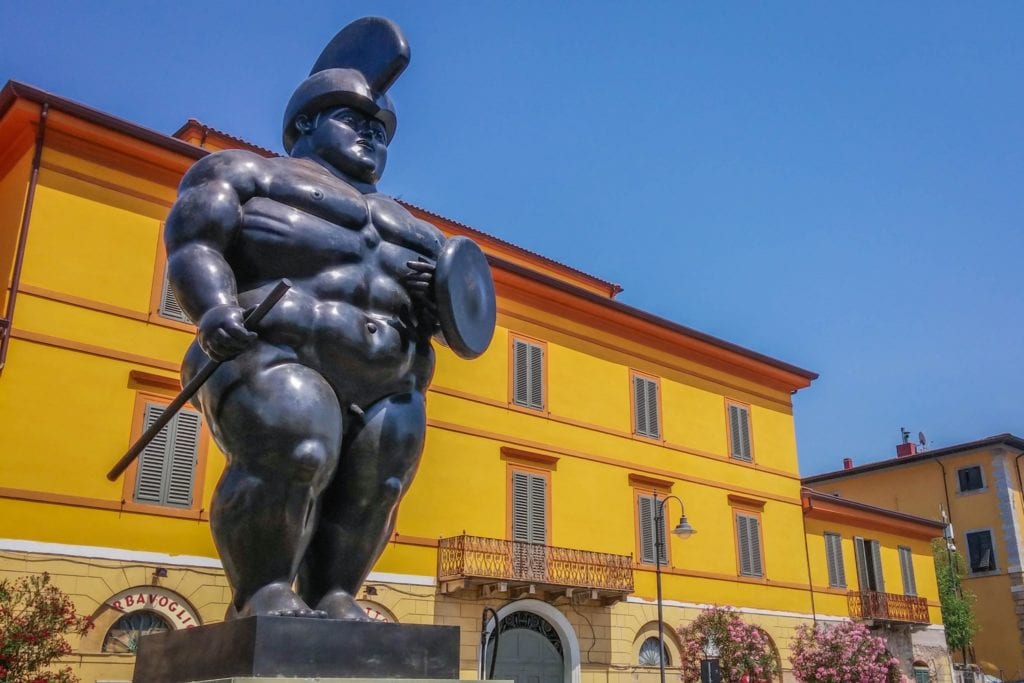
Pietrasanta is a tranquil place during the day. In the summer, while most of the people rest in the sun at the beaches of Versilia, the town takes a nap. Instead, from five pm, Pietrasanta takes its light cotton gown off to wear its best summer dress. All the bars prepare the buffet for the aperitivo, and restaurants set tables on the street for dinner. Hundreds of people crowd the alleys and the square, in a lively and charming atmosphere.
Explore the Piazza del Duomo
The Piazza del Duomo is a chest of treasure holding precious gems. The Duomo, ancient Palazzi, bars, and little shops overlook this wonderful rectangular square. It is the meeting point for locals and tourists, the beating heart of Pietrasanta. During summer it becomes the set of outdoor temporary art exhibits. Artists famous worldwide show their marvelous artworks, made in different materials, in the square, and in the nearby cloister of Sant’Agostino.

The old gate of Pietrasanta
The Rocchetta Arrighina and Porta a Pisa are the most picturesque access to the historical center. The building is the only survivor of the three ancient town gates. You still see flowers on the windows upstairs. Downstairs a couple of nice bars are the best place to enjoy an Italian Aperitif.
Duomo of San Martino
The Duomo of San Martino is the majestic cathedral, built in the fourteenth century, which dominates the square. The facade is covered with white marble. Inside, frescoes and other important art pieces, enrich the allure of the church. The bell tower on the left is completely made of bricks. If you are lucky to find it open, you can get in and see its interior from the base. Stairs go up to the top taking the shape of a spiral.
The white of the facade, the brown of the bell tower, the Tiffany green of the dome, and the blue of the sky create a brilliant mix of colors.
Archeological Museum of Versilia
On the left side of the church, you find the grey and yellow Palazzo Moroni. It hosts the Archeological Museum of Versilia. Pretty small but still interesting, the collection counts findings from prehistoric to medieval, and a collection of Renaissance ceramics.
Town theater
Turning your back to the Dome, on the left corner, there is the Palazzo Pretorio. On the facade, you see marble coats-of-arms from a glorious past. Indeed, it was the old house of the Captain of Justice. Today, the ground floor hosts the town theater. I love the green wooden door with the sign Teatro above. It is a perfect backdrop for a picture.
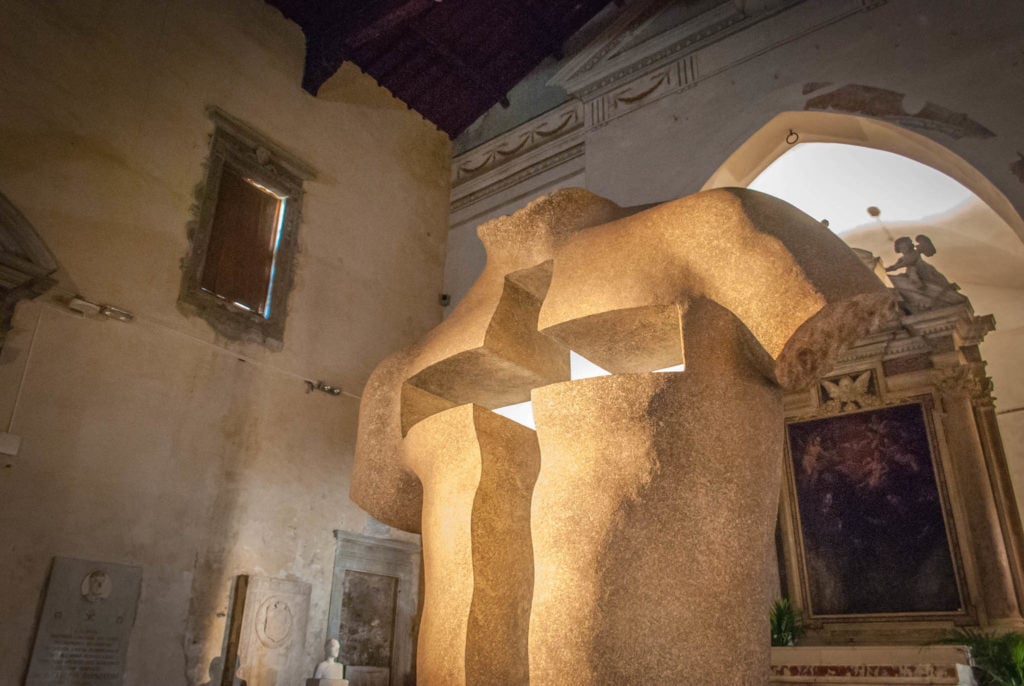
The Complex of Sant’ Agostino
The complex of Saint Agostino with the church and the adjoining cloister dates back to the fourteenth century. It was founded by Augustinian monks. The church in Romanesque style has a marble facade and the apse has a restored wooden choir. Once inside, an explosion of beauty will impress you. Nine different altars, headstones of old noble families, elegant paintings, and frescoes, decorate the wide space.
The church is deconsecrated and is currently the seat of art exhibits. You can imagine how the addition of modern art gives this place a unique charm.
Bozzetti Museum of Sculptures
From a little door, step into the cloister. Marble columns surround the courtyard that today hosts the Cultural Center. Go up to the first floor to enter the quiet Civic Library and the Bozzetti Museum of Sculpture.

The Bozzetti Museum and International Park of Contemporary Sculpture. The park invites visitors to take an open-air tour of more than 600 sketches, models, and drawings of sculptures. All were made and donated to the town by Italian and foreign artists who worked in Pietrasanta.

Climb up to the Rocca di Sala
Between the theater and the Complex of Sant’Agostino, a nice panoramic walk takes you to the top of the hill, to the Rocca di Sala. The elegant noble Palace you see was built in 1408 by Paolo Guinigi. It hosted Emperors and poets but today, unfortunately, it is not open to visitors. From there, you have a splendid view of the town and the surroundings. On a sunny day, you can even glimpse a stretch of the blue sea. My tip is to go at sunset time.
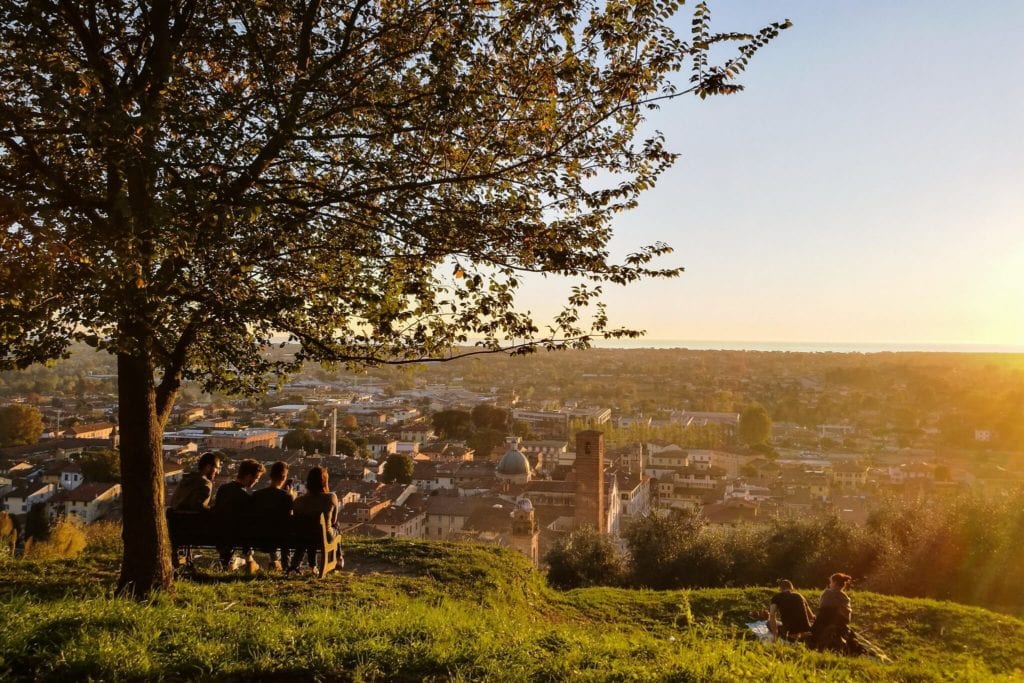
Getting out of the main square…
So far, I told you about the things to see in the main Piazza. As soon as you get out of it, there are other deserving places.

Church of San Antonio Abate
Don’t miss for any reason a visit to the Church of San Antonio Abate. From the Dome square, take the central Via Mazzini until you reach the pink facade of the probably oldest church in town. It exhibits ancient wooden statues of Saints and two unmissable Botero frescoes. The Gate of Heaven and Gates of Hell. At least, his version!
Visit galleries of Modern Art
Being an arty town, the historical center has a lot of art galleries showing elegant, sometimes misunderstood, pieces of modern art. Besides the permanent studios, in the summertime, every garage and property became a temporary exhibit where Italian and international artists show their last artworks.
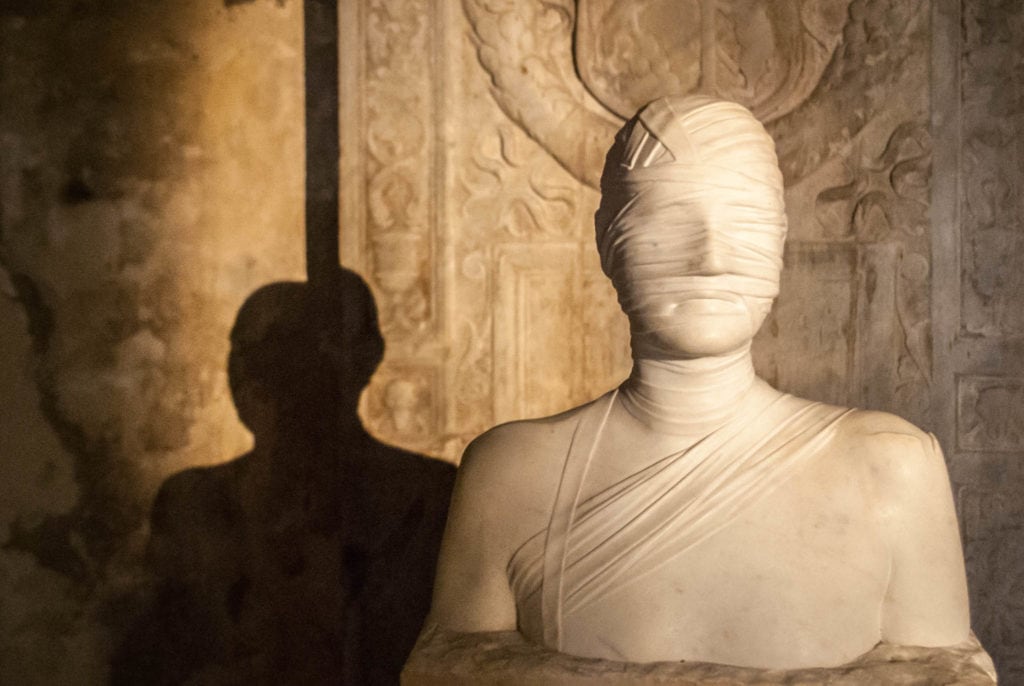
Take a tour of a marble or bronze studio
A visit to a private studio during working hours could be very interesting. You have the opportunity to see people carving a block of white marble or melting bronze to give life to the artist’s idea. Officially, due to security reasons, these kinds of tours are not allowed. Ask the concierge of your hotel or the tourist office kiosk. For sure they have good contacts to organize this unique experience.
MuSA Virtual Museum
The MuSA is the Virtual Museum of Sculpture and Architecture. It opens its doors to visitors during the summer. This modern space is both a virtual museum and an exhibition center of sculpture models. The most interesting thing to do is watch a video projected on 8 different video walls. They tell the story of the area and the process of marble extraction. You find also three big touch screens with information about the local industrial and artisan companies. You can do virtual tours of marble quarries. And even browse the digital library and find artworks made with local marble from all over the world.
Where to eat in Pietrasanta Italy
You have plenty of good choices. It is not easy to give suggestions because most of the restaurants serve great dishes. Consider paying around forty euros for a three-course meal (wine excluded). My tips go to the Vaticano Restaurant to get a delicious Florentine Steak, the Osteria Stappasogni, or the Lunedi dello Studio for the wonderful location, nice staff, and great food.
Where to Sleep in Pietrasanta
Here are four ideas if you wish to spend a few nights downtown:
- Hotel Palazzo Guiscardo. A small boutique hotel in a historical palazzo with a classic style and a touch of modern art. Just outside the pedestrian area, is easily accessible by car without having to worry about entering the car-free ZTL zone without a permit. Coming by car they provide you a special parking permission to park along the street, but for free. Only 9 rooms, all different from each other, get their name from the marble used to decorate the bathroom.
- Paradis Pietrasanta. Probably the fanciest hotel in town, the Paradis overlooks the little Piazzetta Crispi in the pedestrian area. Open only two years ago, it has a marvelous garden, an old medieval tower where they serve you breakfast in the morning, and an excellent restaurant to dine in.
- Art Hotel. Art Hotel is a small three-star hotel recently renowned and located only a hundred meters from the pedestrian area. A big plus is the parking included in the room rate.
- Il Duomo Luxury Suite. The property (it is not a hotel) offers modern rooms that directly overlook the main square. Very central location but you have to leave your car outside the historic center and walk to it.
Where to park in Pietrasanta Italy
The historical center of Pietrasanta is car-free. ZTL which means Restricted traffic zone. You cannot enter with your car unless you have a permit. Pay attention because there are cameras taking pictures of the car plate and you will get the fine directly at home. Out of the pedestrian area, most of the parking slots along the street and in the squares are paid spaces. You can recognize them by the blue lines on the street. White lines usually indicate free parking. But pay attention to the vertical markings because these spaces can be timed parking. However, there are three spacious parking places in town:
- At the BUS terminal. On Google Maps, look for Parcheggio Stazione di Pietrasanta. With the underground walkway beneath the train station, you will conveniently reach the center.
- Next to the Carabinieri station. On Google Maps, look for Parcheggio Gratuito Carabinieri. In one minute you will be at the beginning of Via Garibaldi.
- The third one is the Parcheggio Via Marconi Sosta Libera next to the skate park and just a 5-minute walk from the center.
Curiosities about Pietrasanta
- The Chilean writer Luis Sepulveda passed away in April 2020 due to COVID-19, was Pietrasanta Honorary Citizen.
- The Mexican film director Alfonso Cuaron, Oscar 2014 winner for Gravity and director for Harry Potter and the Prisoner of Azkaban, lives in Pietrasanta with his family.
- The Italian Actress and Hollywood star Gina Lollobrigida, a sex symbol during the 60s, has a place in Pietrasanta. It happened to her to organize exhibitions with her sculptures in the center.
- The famous Colombian artist and sculptor Fernando Botero fell in love with Pietrasanta and he bought a house here. He used to spend a few months a year in Tuscany.
- Igor Mitoraj, the famous Polish sculptor who died in 2014, set up his marble studio in 1983. He has been an honorary citizen of Pietrasanta since 2001.
- During the winter season of 2016, the town center hosted a fascinating exhibit of Salvador Dalì sculptures. Read more here about the Dalì exhibition.
- In the summer of 2017, the sky over Via Mazzini and Via Garibaldi was invaded by thousands of floating colored umbrellas.
If you like it, pin it for Later!
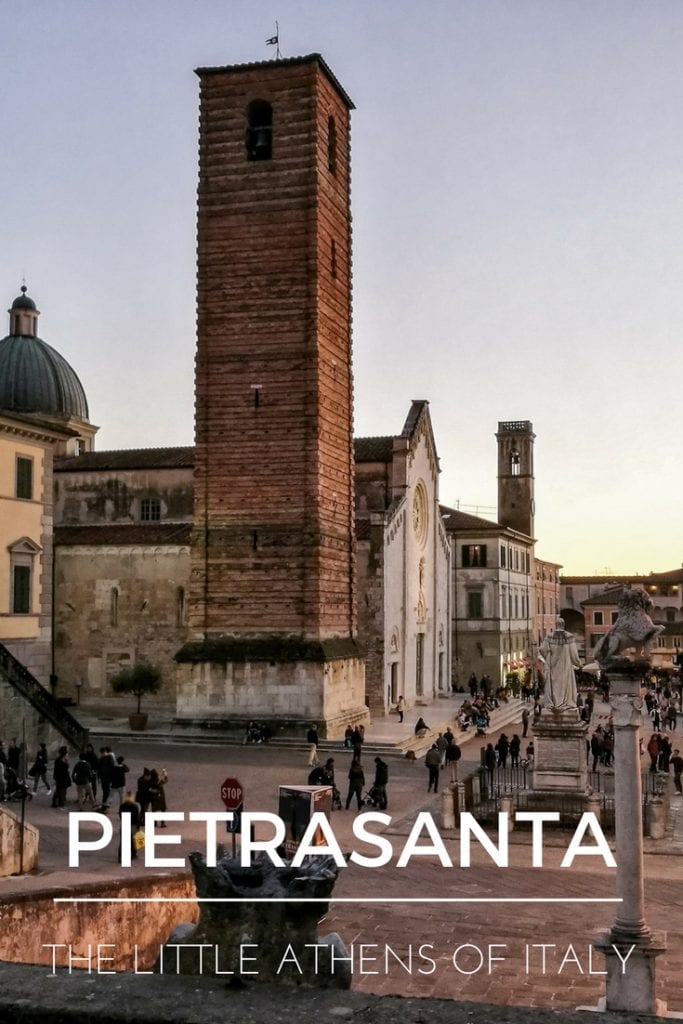
(Updated on the 2nd February 2024)

Very nice article! Our family is from Pietrasanta and we have visited many times. I can’t wait for COVID to be behind us, so that we may return to this wonderful city and it’s people.
Hello Chuck, we are glad you enjoyed reading. Me, Nicola, work in Pietrasanta and I love it. 🙂 Tell us when you come, maybe we can meet for a coffee in the Piazza Duomo. PS: you have the same surname of a dear friend of us. 🙂
Hello dear Nicola!
My name is Chris and I am from Greece. I have been living in Santorini for 3 years where I also met my other half . He is from Pietrasanta and we are usually visiting his beautiful birth town every year.
Now I was having an future plan of living permanently in this beautiful place. It is a surprise so I need from you some info that I can’t ask from my partner about the life there…
I would really appreciate your reply.
Kind regards,
Chris
Hello Chris, thanks for leaving a comment. Which kind of information do you need? But I guess your partner knows Pietrasanta better than me. 🙂
Hello. It is so nice to read about all these beautiful and interesting small cities at the coast of tuscany. We hope it will be possible to go to Tuscany next Easter (early april 2022). Do you think there will be open Hotels, restaurants, museums and shops in the Easter or does everything open up in May?
Dear Marie, many thanks for your comment, and accept my apologies for the delay in replying. Usually, the new season starts with Easter and almost everything is re-opening (bar, shops, restaurants, hotels). I do also work for a small hotel in the heart of Pietrasanta and the re-opening is scheduled for Easter. I really do hope you can visit Pietrasanta.
What is the climate like in late September to early October?
The last year was excellent. still warm with the sun. With the climate changing it isn’t easy to give an exact response but early autumn is a lovely time to visit Tuscany. both for visiting towns and lying on the beach (the water may be colder than in august but still pleasant).
A friend and I are in the planning stages of a trip to Pietrasanta in late October/early November. What is the weather generally like that time of year? Also are there buses to Lucca and Pisa?
Dear Dolores, happy to hear you are coming to Pietrasanta (the town where I work). At that time the weather is usually changeable. not easy to predict. For sure temperatures are still pleasant but you may find cloudy or rainy days. To get to Lucca and Pisa, trains are the best way of transportation. You reach pisa in 20/30 minutes. Lucca in less than an hour (with a change of train).
Thank you for posting this. I’m doing a solo trip to Viareggio in September and plan to visit Pietrasanta as I have historic family ties there.
Dear Danielle, many thanks for your comment. I work in Pietrasanta and I love it. I am sure you will love it too.
Hello, Nicola.
We are planning to go from Florence airport to Marina di Pietrasanta. I am thinking of taking a shuttle train from the airport to Maria Santa Novella station and then train to Pietrasanta. Is this possible? Thank you.
Best regards,
Elena
Dear Elena, thanks for leaving a comment and sorry for the delay. Your idea is a good one. Even because a private drive would cost around 230,00 euros. You will also need a taxi to get from Pietrasanta Train Station (which is downtown, 5 km from the Marina) to your accomodation in Marina. From the train station there are also buses to the Marina.
Ciao Nicola,
We are from Sydney and will be visiting our favourite country Bella Italia in a few days .
While researching I came across your very interesting article on Pietrasanta which we would love to visit on our trip .We will be based in Viareggio .Please can you advise how we can get to Pietrasanta as it is the first time , after multiple visits to Italy ,that we will not be driving . I appreciate any info you can give us ….maybe your favourite cafe , trattoria ? Grazie Mille Roberta….in Italy!!!
Hey Robyn Roberta, so happy you came across our website and thanks for writing. Staying in Viareggio don’t miss Pietrasanta. Train is perfect, only 5/10 minutes from Viareggio station to Pietrasanta. In Pietrasanta, you get out of the station and you are already downtown. There is an excellent gelateria just outside the train station called “La Cremeria”. The best Gelato in town. For a coffee or an aperitivo take a sit in one the cafes in the main square Piazza del Duomo (bar michelangelo, bar pietrasantese, bar/bakery il Duomo). To dine I highly recommend “Osteria Stappasogni”, “Marzocco Restaurant”, “Lunedi dello Studio”, and finally “Vaticano” for meat and steak.